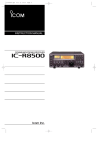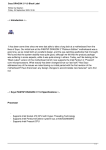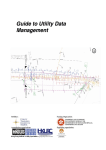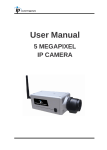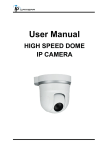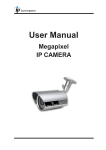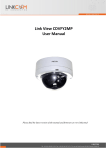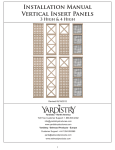Download Blomberg WAF 1520 Operating instructions
Transcript
Automatic
Washing Machine
WAF 1500 A
WAF 1520 A
WAF 1540 A
WAF 1560 A
Operating instructions
Read this first!
Contents
Dear customer,
By purchasing this appliance you have decided in favour of the latest in washing
technology – premium quality, long service live, high reliability and optimal ease of
use.
• At first, please check if the appliance
was received undamaged.
• If a transport damage is noticed, notify
your supplier immediately; do not operate the appliance!
Machine overview . . . . . . . . . . . . .
Safety first . . . . . . . . . . . . . . . . . . . .
Disposal. . . . . . . . . . . . . . . . . . . . . .
Installation. . . . . . . . . . . . . . . . . . . .
2
4
5
5
Removing the transportion locks . . . . . . . . . .
The right location of installation . . . . . . . . . . .
Levelling the machine. . . . . . . . . . . . . . . . . . .
Connecting the water supply . . . . . . . . . . . . .
Connecting the water drain . . . . . . . . . . . . . .
Electrical connection . . . . . . . . . . . . . . . . . . .
Language selection. . . . . . . . . . . . . . . . . . . . .
The First Use. . . . . . . . . . . . . . . . . . . . . . . . . .
5
6
6
6
7
8
8
9
These operating instructions…
Preparing to wash . . . . . . . . . . . . . . 9
…are intended to help you operate this
appliance quickly and safely.
• Read these instructions before installation and initial operation.
• Pay special attention to the safety instructions.
• Keep the instructions for future reference.
• If you sell this appliance, pass on the
instructions to the new owner.
• In addition, read all the documents,
that you get with the appliance in addition to these operating instructions.
Please note that these operating instructions are applicable to several models. The
differences between the models are clearly
emphasised.
Sorting the laundry . . . . . . . . . . . . . . . . . . . . 9
Preparing clothes for washing. . . . . . . . . . . . . 9
The right load capacity . . . . . . . . . . . . . . . . . 10
Detergents and softeners . . . . . . . . 11
The detergent dispensing drawer . . . . . . . . .
Dosing devices . . . . . . . . . . . . . . . . . . . . . . .
Liquid detergent. . . . . . . . . . . . . . . . . . . . . .
Choice of detergent . . . . . . . . . . . . . . . . . . .
Detergent quantity . . . . . . . . . . . . . . . . . . . .
Fabric softener . . . . . . . . . . . . . . . . . . . . . . .
Starch. . . . . . . . . . . . . . . . . . . . . . . . . . . . . .
11
11
11
11
11
12
12
Washing programmes . . . . . . . . . . 12
Programme selection . . . . . . . . . . . . . . . . . . 12
Main programmes . . . . . . . . . . . . . . . . . . . . 12
Special programmes. . . . . . . . . . . . . . . . . . . 13
Additional functions. . . . . . . . . . . . 13
Explanation of symbols
Throughout these instructions the following symbols are used:
B High voltage! Risk of electric shock!
of other personal injury or properA Risk
ty damage.
information or useful ad3 Important
vise.
1
The buttons . . . . . . . . . . . . . . . . . . . . . . . . .
Prewash . . . . . . . . . . . . . . . . . . . . . . . . . . . .
Intensive. . . . . . . . . . . . . . . . . . . . . . . . . . . .
Soak . . . . . . . . . . . . . . . . . . . . . . . . . . . . . . .
Easy iron. . . . . . . . . . . . . . . . . . . . . . . . . . . .
Quick wash . . . . . . . . . . . . . . . . . . . . . . . . .
13
13
13
13
13
13
Temperature selection . . . . . . . . . .
Spin speed selector . . . . . . . . . . . .
Balance time display . . . . . . . . . . .
Time delay . . . . . . . . . . . . . . . . . . .
Programme Progress . . . . . . . . . . .
Door lock . . . . . . . . . . . . . . . . . . .
Child-proof lock. . . . . . . . . . . . . . .
Quick instructions for daily use . . .
Programme table . . . . . . . . . . . . .
Cleaning and care . . . . . . . . . . . . .
Troubleshooting . . . . . . . . . . . . . .
Tips for removing stains . . . . . . . .
Technical specifications
and consumption data . . . . . . . . .
14
14
15
15
16
16
17
17
19
21
24
25
26
Machine overview
1
2
6
7
8
3
9a
4
5
1
Detergent dispensing drawer
6
Drain hose
2
Control panel
7
Power cable
3
Loading door with door opener
8
Transit bars
4
Service door with foreign matter trap
9a
5
Height-adjustable feet
Water supply hose with
"Aquasafe+"-protection
9b
Water supply hose with
"Aquasafe"-protection
(alternative to 9a, supplied in drum)
9b
Accessories (in accessory bag):
10
11
10
11
2
Holder for drain hose
Five caps for rear wall opening
12
13
14
19
18
15 16
17
21
20
12
Programme button
17
On/Off button
13
Display
18
Spin speed button
14
Temperature button
19
Additional functions
15
Turning knob
20
Programme progress indicator
16
Start/Pause button
21
Time delay button
Overview of additional functions
Aquasafe
In case of leakages, the water supply is mechanically
blocked.
Aquasafe+
In case of leakages, the water supply is electrically
blocked.
Aquaround
The detergent is optimally utilised through an automatic suds circulation.
Sensorinse
If residues of detergents still exist after the rinse cycle,
the machine introduces additional rinse cycles.
3
WAF 1560 A
WAF 1540 A
Function
WAF 1520 A
Option
WAF 1500 A
Model
• • • •
• • • •
• • • •
Safety first
not attempt to dry-clean with the
A Do
machine! Fire and explosion hazard!
Please observe the following information,
as otherwise there will be risk of personal
injury or material damage and any warranty and liability is invalidated.
• Rinse garments pre-treated with cleaning agents (petroleum ether, liquid
stain remover, etc.) thoroughly in
clear water before washing.
Intended use
• This appliance shall only be used for
washing, rinsing and spinning textiles
that are marked accordingly.
• Only detergents, softeners and additives suitable for use in washing machines may be used.
• Follow the care instructions in the garments and the information given by
the washing detergent manufacturer.
wash down the appliance with
B Never
a water hose! Risk of electric shock!
Always disconnect from the mains by
unplugging before cleaning.
• Never touch the plug with wet hands.
Never pull on the cable to unplug, always pull on the plug only.
not operate the appliance if the
B Do
power cable or power cable plug is
Safety instructions
faulty or the appliance shows any other faults! Risk of electric shock!
• For malfunctions that cannot be resolved by following the information in
these operating instructions:
Turn off the machine, pull the plug,
close the water tap and contact the
customer service centre.
• This appliance must be connected to a
properly installed earthed outlet,
which is protected by a fuse of adequate capacity.
supply hose with Aquasafe+ conB The
tains parts, that are energised. Do not
damage supply hose and Aquasafe+!
Risk of electric shock! Do not use the
appliance if damage to the supply
hose is noticed and contact the customer service.
• Supply and drain hose must always be
securely fastened and in perfect condition.
A
attempt to repair the machine
B Never
by yourself. This may put your life and
the lives of others in danger.
Only authorised electricians, such as
our customer service staff, are permitted to repair electrical appliances.
If there are children in your household...
• Keep children away from the machine.
Electrical appliances are not toys.
• Pull out the plug when the machine in
not in use.
• Keep the loading door closed when
you leave the room.
Do not use a washbasin or bathtub to
which the drain hose is attached while
the machine is running. Risk of scalding due to high washing temperatures!
open the loading door or unA Never
screw the foreign matter trap, if there
is still water in the drum (e.g. after a
power failure). This poses a risk of
flooding and possible scalding due to
hot suds.
open the locked loading door
A Never
by force! Inform the customer service,
if the loading door cannot be opened
even a few minutes after programme
finishes.
4
Disposal
Where to dispose of the packaging?
packing is not to be disposed of in
3 The
the regular household refuse!
material can be dangerous
A Packaging
to children. Keep the packaging mate-
What to do with the old machine?
rial out of reach of children, or dispose
it of according to instructions.
The packing is made of materials which
can be recycled.
• Separate the packing material by type:
– Styropor® parts and film go for collection as potential recyclable;
– Wooden parts go into bulky refuse.
Dispose of your old appliance in an environmentally friendly manner.
• Ask you dealer or your local refuse collection service how to best dispose of
your old appliance.
disposing old machine, pull out
A Before
the mains plug, cut through the the
mains lead and make the door lock
unusable – so as not to pose a risk to
children.
Installation
Removing the transportion locks
1. Loosen all five bolts with the spanner
until they turn freely.
the washing machine is operatA Before
ed, the transit bars must be removed!
The machine will otherwise be damaged.
Tool needed:
10 mm spanner.
2. Remove the transport bolts by turning
them slightly.
5
If, for example, the washing machine
and a dryer are stacked upon each
other, they can – when loaded – have
a total weight of up to 180 kg.
Important:
• Do not stand appliance on the power
cable.
• Keep at least 1cm distance to walls of
other furniture.
• Place the machine on a firm surface,
never on a long-pile carpet or similar
surface.
Levelling the machine
3. Place the five covers (from the accessories bag) onto the openings in the
rear panel and use a suitable tool
(such as the handle of a screw driver)
to push them into place. The smaller
cover is intended for the top-mot
opening.
use a tool to loosen the lock
A Don't
nuts to avoid damaging them.
1. Loosen the lock nuts on the feet.
2. Adjust the feet until the machine is
level and stands steady.
3. Important: Retighten all lock nuts.
Connecting the water supply
The machine can be connected to water
taps with 3/4 inch BSP thread.
Important:
• Bear the permissible water pressure in
mind (see "Technical specifications").
Attach a pressure reducing valve if water pressure is higher.
• Do not connect to a water heater (instantaneous water heater or unpressurised boiler), as the water pressure is
insufficient.
• Check with customer service for hose
extensions. Do not use homemade extensions with hose clamps or similar!
• Use only the new hose supplied with
the machine, not an old existing one!
• Ensure that there are no sharp bends
in the hose!
Store the transit bars in a safe place.
• They will be required if the washing
machine is to be transported again
(e.g. if you move house).
transport the appliance without
A Never
installed transit bars!
The right location of installation
Install the appliance in a stable, level position in frost-free surroundings.
there is danger of frost, drain all reA Ifmaining
water (see "Care and maintenance").
floor must have sufficient loadA The
carrying capacity!
A Do not use a tool to tighten.
6
1. If not already attached, manually
screw the bent end of the supply hose
tightly onto the rear panel of the machine (not in case of Aquasafe+).
nect it permanently to a drain pipe (siphon
trap).
Important:
• Do not run the drain hose higher than
100 cm above floor level for the suds
pump to be able to pump out. Don't
go below the minimal height of
40 cm, otherwise water will come out.
2. Screw the Aquasafe or Aquasafe+ (depending on the model) at the end of
the supply hose tightly onto the water
tap by hand.
.
Aquasafe or Aquasafe+ (depend3 The
ing on model) turns off the water sup-
• The water must be able to run off unhindered. Washbasins with a small
drain are not suitable.
• The end of the hose must not immerge in the pumped-out water.
• Check with customer service for hose
extensions. Do not use homemade extensions with hose clamps or similar!
• Use only the new hose supplied with
the machine, not an old existing one!
• Ensure that there are no sharp bends
in the hose!
ply should a leakage occur in your
hose.
3. Turn the water tap all the way on and
check all connections for leaks; turn
the water tap off again. Correct the
position of seals and screw couplings,
if necessary.
Connecting the water drain
You can hang the drain hose over the edge
of a wash basin, sink or bathtub – or con-
7
G
Fastening the hose holder:
1. Pull the holder included in delivery
over the end of the hose.
• The stated voltage must match with
your mains voltage.
• Connection by extension cables or
trailing sockets is not permitted.
damaged power cable must be reB Aplaced
by a qualified electrician.
2. Hand the drain hose with the holder
over the edge of the basin or tub and
secure it from sliding off – e.g. by fastening it with a chain around the water tap.
Language selection
Permanent connection to a siphon trap:
A qualified plumber should attach the
hose to prevent the hose from slipping
off. There is a risk of flooding.
The language in which the washing programmes and messages are displayed 13
can be changed after the machine is
switched on.
Unless the appliance has been repaired it must not be operated! Risk of
electric shock!
A
13
Electrical connection
Connect the appliance to a properly installed earthed outlet, which is protected
by a fuse of adequate capacity.
Important:
• The connection must conform to the
applicable regulations in your country
and those set by your electricity
board.
• The power cable plug must be accessible after installation.
• Voltage and rated fuse protection is
specified on the type plate located on
the back of the loading door.
G
12
21
1. Press 12 button.
2. Turn the knob, until the setting function appears on the display.
is no programme duration dis3 There
played for this function, so it is easy to
recognise in every language.
3. Press 12 button.
4. Turn the knob, until the desired language is displayed.
5. Press >Start/Pause< button to accept
the language setting.
6. Press 21 button to go back to programme selection.
8
The First Use
5. Select >Cotton< programme (see "Programmes").
6. Press >Start/Pause< 16 button.
to the section on "Troubleshoot3 Refer
ing" if the machine can't be switched
of abnormal sounds or leakage
A Inof case
water: Press >On/Off< 17 button,
on.
To flush out any remaining test water, the
first washing cycle should be run without
any laundry.
1. Open water tap fully. Check if hoses
are firmly attached.
2. Check that the drum is completely
empty; close the loading door.
3. Add a small amount of detergent to
the second compartment; close detergent dispensing drawer.
4. Press >On/Off< 17 button. Some information appears on the display after a
few seconds.
close water tap and pull mains plug
out of the socket. Check to see that all
transit bars have been removed and
the hoses are properly connected.
After completion of the programme cycle:
The loading door can be opened
when the symbol >Door lock< in the
display goes out (see "Door lock").
1. Press >On/Off< 17 button.
2. Turn the water tap off.
3. Leave loading door and detergent dispensing drawer open to dry.
3
Preparing to wash
Sorting the laundry
• Don't wash coloureds and whites together. New, dark coloured cottons
will stain very much.
• Sort the laundry by type of fabric, colour, degree of soiling and permissible
water temperature.
Preparing clothes for washing
follow the recommendations
A Always
on the garment label.
of laundry with metal parts
A Items
(e.g.underwire bras, belt buckles, metal buttons) will damage the machine.
Remove metal parts or place the items
in a cloth bag, pillow case, or something similar.
Type of textiles and care symbols
Whites/coloureds: cotton, linen
Easy-care: Synthetics (polyester, polyamide); Blended fabrics (with cottonit
Baumwolle)
Delicates: Delicate fabrics
(rayon, silk, etc.); Curtains
Woollens: Only with wool stamp and labelled "Machine washable"
machine
washable
Hand wash:
Do not wash:
9
The loading door
• Empty pockets, remove all foreign objects (e.g. coins, pens, paper clips). If
possible: Turn pockets inside out and
brush.
• Place small items of laundry (e.g.
tights) in a cloth bag, pillow case or
something similar. This can also help
you to avoid searching for lost socks.
• Handle curtains with special care. Remove non-stainless curtain runners
and lead tape. Place runners that can't
be removed in a cloth bag, pillow case
or something similar.
• Close zippers, sew on loose buttons,
mend unstiched seams and tears.
• Only wash woolens that are labelled
"machine washable" or "handwashable" – and only with the appropriate
programme.
• Wash new coloured items of laundry
separately – they may "bleed".
• Heavy stains should be treated appropriately before washing. If in doubt,
check with a chemist or dry-cleaner.
• Use only dyes/discolouring and antiliming agents suitable for machine
wash. Make sure to follow the instructions on the package.
• Wash jeans and delicates inside out.
• Keep laundry items made of Angorawool in the freezer compartment for a
few hours before washing – this reduces number of fluff balls formed.
loading door is locked when a
3 The
programme is running; the >Door
lock< 22 symbol is then lit up.
The loading door can be opened
when the >Door lock< symbol goes
out.
22
• To open the loading door, pull it with
the door opener.
• Place laundry items loosely in the
drum; Add detergent if necessary (in
an eco bag or dosing ball).
• Push the loading door firmly shut until
you hear it lock into place. Take care
no clothes are caught in the door.
The right load capacity
• The maximum load capacity depends
on the type of laundry, the degree of
soling and the wash programme you
wish to use.
follow to the information in the
A Please
"Programme table".
Washing results are adversely affected
by an overloaded drum.
3 Always try to utilize the max. load.
10
Detergents and softeners
The detergent dispensing
drawer
• Use the detergent manufacturer's dosing cup and follow the instructions on
the package.
The detergent dispensing drawer comprises 3 compartments:
– left compartment ( II) for main wash
– middle compartment for fabric softener
– right compartment ( I) for pre-wash
Choice of detergent
The type of detergent used depends on
the type of textile, colour, degree of soiling
and desired washing temperature.
• Use regular detergent for cottons (60 95 °C), otherwise use special detegent
for coloured and delicate wash.
• Wash woollens only with a special detergent for woollens.
• Detergents using a modular system allow you to add bleach and softener individually.
• Use only detergents suitable for washing machines.
Detergent quantity
The amount of washing detergent to use
depends on the amount of laundry, the
degree of soiling and water hardness.
• Always add detergent and fabric softener before starting the wash programme.
your local waterworks for the cur3 Ask
rent level of water hardness.
open the detergent dispensing
A Never
drawer while the wash programme is
1
2
3
4
still running!
Dosing devices
In case of programme without pre-wash,
you can add washing detergent directly to
the drum with a detergent bag or a dosing
ball.
Water hardness levels
0… 7
0…1.3
soft
1.3…2.5
7…14
medium
2.5…3.8 14…21
hard
> 21
> 3.8
very hard
mmol/l
°dH
• It is absolutely necessary you proportion as recommended on the packing!
• For small amounts of laundry or only
slight soiling use accordingly less detergent.
Liquid detergent
When using liquid or gel-like washing detergents, please note the following:
highly concentrated detergents
A Dose
very precisely.
detergent may cause stains on
A Liquid
your laundry if a time delay has been
set.
• Don't use liquid detergent if you want
to wash using the time delay feature.
• Don't use liquid detergent for the
main wash in a cycle with pre-wash.
Too much detergent causes an excessive
amount of foaming, bad washing and rinsing results and a strain on water resources.
11
Too little washing detergent causes laundry to turn grey and calcification of the
machine.
you use dryer or dry your laundry
3 Ifoutdoors,
you do not need fabric sof-
Fabric softener
Starch
tener.
Fabric softener is added into the middle
compartment of the detergent dispensing
drawer.
• Proportion as recommended on the
packing!
• Fill only up to the mark level (> max<).
• Dilute viscous fabric softener with water before adding.
• Add liquid starch and fininshing agent
into the middle compartment.
• Mix powdered starch according to the
directions on the package and like fabric softener, add to the middle compartment.
• Never use fabric softener and starch
together in the same washing cycle.
• Wipe off the drum after using starch.
Washing programmes
Programme selection
boil-proof clothes (90 °C). Increased
hygiene is provided by an extended
boiling period and an extra rinse cycle.
Useful for baby-clothes and clothes
worn by sick persons.
• Active 40
This programme thoroughly exploits
the detergent at 40 °C and thus saves
energy. Suitable for garments for
which you would otherwise use the
Cotton 60 °C programme.
• Mini
Use this programme, for quickly washing small number of cotton/blended
fabrics. Suitable for clothes that are
normally worn for a short time such as
sportswear.
Each of these main programmes comprises
a complete washing process, including
washing, rinsing and if required, spin cycles.
Press 12 button to select a washing programme. The desired programme can
then be set with the rotary knob. The display shows the programmes in the selected language (see "Language Selection).
12
You will find an overview of the programmes in the "Programme table".
programme starts only when the
3 The
>Start/Pause< button is pressed.
Main programmes
Depending on the type of textile, the following main programmes are available:
• Cotton
• Synthetics
• Delicate
• Woollen
• Handwash
For special cases extra programmes are
available:
• Hygiene +
This programme is only suitable for
match the programme to the
A Always
fabric type, colour, degree of soiling
and permissible water temperature.
Always follow the recommendations
on the garment label.
Different temperatures can be selected in
most main programmes.
the temperature only as high as
3 Select
absolutely necessary.
A high temperature means high power consumption.
12
should reduce the speed for deliA You
cate fabrics!
Special programmes
m
For specific applications you can select any
of the following special programmes:
• Rinse
Use this programme e.g., when you
want to soft rinse or starch separately.
• Spin
This programme spins with maximum
possible speed in the default setting.
• Pump
This programme allows you to drain
water, e.g. when you put already
soaked clothes into the appliance and
want to wash them at a later time.
Additional functions
The buttons
• With this button normal soiled synthetics can be washed at 40 °C instead
of 60 °C.
on the programme, cer3 Depending
tain additional functions 19a to 19e
Intensive function can only be
3 The
used together with the Prewash func-
can be added by pressing a button.
tion. As soon as you press the Intensive button a pre-wash cycle is automatically added to the programme.
Soak
It is possible to have the laundry soaked
before the washing cycle starts with the
19c button. This gives better washing results for badly soiled clothes.
19a 19b 19c 19d 19e
• Press the required buttons before
starting the programme.
• Meaningless combination of buttons
cannot be selected together. Example:
>Intensive< 19b and >Quick wash<
19e.
Easy iron
If you press the button 19d, the drum
movement is reduced and spinning is limited to reduce creasing. In addition, the
washing is done at a higher water level.
• Use this button for delicate fabrics that
easily crease.
Prewash
A pre- wash can be activated with the 19a
button.
A The maximum load is then
– for linens/coloureds: . . . . . . . 3.0 kg
– for synthetics: . . . . . . . . . . . . 1.5 kg
– for delicate fabrics: . . . . . . . . 1.0 kg
pre-wash is only worth while with
3 Aheavily
soiled laundry.
Without prewash you save energy,
water, washing powder – and time.
Quick wash
With button 19e the wash time is shortened.
• Use this function for small loads or less
soiled laundry.
Intensive
The 19b button extends the washing time
in the main wash cycle. Washing powder
can work more effectively and you can
wash at lower temperatures – thereby saving energy.
• With this button normally soiled linens/coloureds can now be washed at
60 °C instead of 90 °C.
13
Temperature selection
The selected temperature is shown on the
display beside the >Temperature selector<
14 button.
It is possible to select among several temperature settings for some washing programmes:
1. Press 14 button.
2. Set the desired temperature by turning the knob.
14
Spin speed selector
appropriate maximum spin speed
3 The
is automatically set in each pro-
(to protect against creasing). Symbol
18a starts blinking when the Rinse
hold stage is reached. For procedure
after this, see "Quick instructions for
daily use".
gramme and additional function.
The current value is shown on the display next to the >Spin speed selector<
button 18.
higher the spin speed, the lower
3 The
the residual moisture.
If you wish to dry your laundry subsequently in a dryer, select the maximum possible speed – this saves energy when drying.
18
18a
18b
18c
You should reduce the speed for especially
delicate fabrics.
1. Press button 18.
2. Set the desired speed with the rotary
knob.
• In the >No spin< 18c setting no spinning takes place; water is only drained.
• In the >Rinse hold< 18b setting the
programme stops after the last rinse
cycle. The laundry remains in water
14
Balance time display
When a programme is running, the display
shows the time remaining for the programme to complete. The time is displayed in hours and minutes as "hh:mm".
length of a programm depends
3 The
on the type of program and the additional functions selected. The details in
the table "Technical data and consumption figures" refer to programms
without additional functions.
Time delay
With the time delay function you can delay
the programme start. You can enter a time
delay of up to 24:00 hours. Setting can be
made in increments of 30-minutes.
dicator lamp goes out and the washing cycle begins.
Changing the delay time
If you want to change the time during the
countdown:
1. Press the >Start/Pause< button. The
colon at the centre of the display stops
blinking.
2. Press 21 button.
3. Set the desired time delay with the rotary knob.
4. Press the >Start/Pause< button. The
time delay countdown phase begins.
The colon at the centre of the displayed time delay starts blinking.
not use liquid detergent when you
A Do
set time delay! Risk of staining of the
clothes.
21
21a
1. Open tap, load laundry and fill in detergent.
2. Set the wash programme, temperature, spin speed and if necessary additional functions.
3. Press 21 button.
4. Set the desired time delay with the rotary knob. The set time is shown on
the display together with the 21a symbol.
5. Press the >Start/Pause< button. The
time delay countdown phase begins.
The colon at the centre of the displayed time delay starts blinking.
Cancelling the time delay
If you want to cancel the time delay countdown and start the programme immediately:
1. Press the >Start/Pause< button. The
colon at the centre of the displayed
time delay stops blinking.
2. Press 21 button.
3. Set the time delay to "00:00" with the
rotary knob.
4. Press the >Start/Pause< button to start
the programme.
the time-delay period more
3 During
laundry can be loaded. At the end of
the time delay countdown the 21a in-
15
Programme Progress
>Softener<
The 20d symbol lights up at the beginning
of the softener phase.
>Spin<
The20e symbol lights up at the beginning
of the final spin cycle – after the soft rinse
cycle or in the special programmes for
>Spin< and >Pump<.
The progress of a running programme is
indicated by a series of symbols on the display.
20a 20b 20c
20d 20e
the machine isn't spinning, the pro3 Ifgramme
may be in rinse hold.
the beginning of every programme
3 At
step, the corresponding symbol in the
Or the automatic spin correction system has been activated due to excessive imbalance.
Interrupting the programme
A programme can be interrupted by pressing the >Start/Pause<16-button. The buttons starts blinking.
To continue the programme, press the 16
button again.
symbol array starts glowing and all of
them go out together at the end of
the programme. The right most glowing symbol in the array indicates the
current step being executed.
>Prewash<
The 20a symbol lights up at the beginning
of the pre-wash cycle – when a programme with pre-wash is selected.
>Main wash<
The 20b symbol lights up to indicate the
beginning of the main wash cycle.
>Rinse<
The indicator lamp 20c lights up at the beginning of the rinse cycle.
16
Door lock
The symbol 22 lights up when the loading
door is locked.
22
16
Child-proof lock
With the Child-proof lock you can guard
the appliance against children's hands. No
changes can then be made to a running
programme.
To activate the Child-proof lock:
• Press and hold the buttons 14 and 18
simultaneously for approx. 2 second,
until the display confirms the activation of child-proof lock
To deactivate the Child-proof lock:
• Press and hold the buttons 14 and 18
simultaneously for approx. 2 seconds,
until the display confirms the deactivation of the child-proof lock.
14
18
Quick instructions for daily use
Preparation
Adding more laundry
1. Open water tap fully. Check if hoses
are firmly attached.
2. Place laundry in the drum.
3. Fill in detergent and fabric softner.
is possible only:
3 This
– during a time delay,
Starting
1. Press the >On/Off< button.
2. Select programme and temperature.
3. If desired:
– select any additional function(s),
– set the spin speed,
– set time delay.
4. Close the loading door.
5. Press the >Start/Pause< button.
The display shows the time remaining
for the programme to complete.
6. Check if the >Door lock< symbol on
the display has lit up (if not, see "Troubleshooting").
1.
2.
3.
4.
– at the beginning of a washing cycle
(the appliance allows adding laundry at a later stage only when the
water level is low or the temperature
is low).
Press the >Start/Pause< button.
Open the loading door and put in
more laundry.
Close the loading door.
Press the >Start/Pause< button.
Programme is in rinse hold
is indicated by the blinking spin
3 This
symbol and >Start/Pause< button.
If you now want to spin:
1. Set spin speed.
2. Press the >Start/Pause< button.
The programme continues, pumps out
the water and spins.
If you want to pump out the water:
• Press the >Start/Pause< button.
The programme continues and only
pumps out the water.
Aborting a programme
• Press and hold the >Start/Pause< for
approx. 3 seconds.
The machine may pump out any water still in the drum or goes through a
rinse cycle to cool off the laundry.
17
Re-spinning the laundry
automatic spin-correction-system
3 The
can prevent spinning in case the drum
is out-of-balance.
If you wish to spin again:
1. Rearrange the laundry evenly in the
drum.
2. Set >Spin< programme.
3. Set spin speed.
4. Press the >Start/Pause< button.
After the programme cycle is
completed
>Programme progress< array of
3 The
symbols on the display goes out when
the programme is over.
1. Open the loading door and remove
the laundry when the >Door lock<
symbol on the display goes off.
2. Press >On/Off< button.
3. Turn the water tap off.
4. Wipe out the fold in the rubber seal on
the door and check for foreign objects.
5. Leave loading door and detergent dispensing drawer open to dry.
18
Programme table
Time delay
Spin max.
Rinse hold
6,0
2,5
40° to 60°
3,0
Cold up to 30°
Delicate
Delicates (rayon, silk, etc.) and Cold up to 40°
curtains
2,0
Woollen
Only if labelled "machine
washable"
1,5
Handwash
Labelled "wash by hand"
Quick wash
Care symbol
Synthetics
Synthetics (polyester, polyamide) and blended fabrics
(with cotton)
Easy iron
6,0
Soak
Hygiene +: cotton with high
95°
demands for hygiene
Active 40: cotton
40°
(energy saving-programme)
Mini: Cotton, blended fabric Cold up to 30°
(short programme)
Intensive
6,0
Cotton
Durable fabrics made of
cotton and linen
Prewash
Load (kg)
Cold up to 90°
Programme /
Fabric type /
Remarks
Temperature (°C)
Option
Cold up to 40°
Cold up to 30° 1,5
Special programmes
Rinse (Softener, Starching)
as
above
as
above
Spin
Pump
Individually selectable, in part selectable in combination; illogical combinations are blocked.
1600 rpm (depending on model)
800 rpm
600 rpm
When ' soaking ' function is selected, the program follower leds will start to run from prewash step.
19
Rinse cycles with
intermediate spin
Rinse cycles without
intermediate spin
Final spin
Cotton
Standard programme
1
3
–
1
Hygiene +
1
4
–
1
Active 40
1
3
–
1
Mini
1
–
2
1
Synthetics
Standard programme
1
3
–
1
Delicate
Standard programme
1
–
3
1
Woollen
Standard programme
1
1
2
1
Handwash
Standard programme
1
–
2
1
Special programmes
Rinse
–
2
1
–
Spin
–
–
–
1
Pump
–
–
–
–
Programme
Main-wash cycle
Programme steps
The actual number of programme steps can be different from those given
above depending upon the function.
20
Cleaning and care
Detergent dispensing drawer
Clean when necessary:
1. Open the drawer as far as possible.
2. Push down the depression on the suction cup and pull the drawer out completely.
4. Wipe off detergent residue from the
drawer guides. If present, remove calc
deposits from the water-jet nozzles
(inside the drawer).
Loading door and drum
After each wash:
• Wipe off the fold in the rubber collar
and check for foreign objects.
3. Clean the drawer under warm running
water. Pull off the suction cup; Clean
suction cup and opening in the drawer with warm running water, pierce
the opening with a needle if necessary. Replace the suction cap.
• Check drum for foreign objects.
21
stains may occur due to foreign
A Rust
objects made of metal. In such cases:
Clean the drum with a stainless steel
cleaning agent. Never use steel wool
or scrub sponges.
Housing and control panel
When necessary:
• Clean cabinet with soap suds or a mild
cleaner; wipe dry with a soft cloth.
• Use only a soft, damp cloth to clean
the control panel.
use a scrub sponge or a scourA Never
ing agent. These will damage the
enamel and plastic parts.
Foreign matter trap
• Clean the foreign matter trap at least
once after every 30 wash cycles!
• Clean foreign matter trap, if foreign
objects (coins, buttons, baby socks,
etc.) are blocking the suds pump.
• Clean the foreign matter trap, when
the message >Pls Check The Filter< appears.
• Drain left-over water before cleaning
(see below).
Draining remaining water
Drain off the water completely…
• before cleaning the foreign matter
trap;
• before transporting the machine (e.g.
when shifting house);
• when there is a power failure ("emergency draining");
• when there is a danger of frost.
may be more than 20 litres of
A There
water left in the machine when the
drum is bull (e.g. after a power failure)!
3. Turn the foreign object trap 1/2 turn
to loosen it (anti-clockwise) and soak
up the remaining water with a cloth.
Once no more water is coming out,
turn the foreign object trap until it is
completely free and remove it.
room temperatures below 0 °C the
A At
remaining water in the appliance
could freeze, damaging it.
1. Switch appliance off, unplug the power cable, close the water tap.
hot suds to cool off sufficiently.
A Allow
This poses a risk of scalding.
2. Open the service door by pushing on
the button. Take out the drain pipe
and hold it over a bowl. Pull the seal
off the drain hose and allow the water
to drain out one bowl at a time.
G
22
4. Clean foreign object trap and the
pump opening. Check if the pump impeller (in the pump opening) can be
turned freely.
5. Replace the cap on the drain hose and
put it away.
6. Replace the foreign object trap and
turn it tight (in clockwise direction).
7. Close the service door.
4. Pull out the strainer in the back wall
(except in case of Aquasafe+) with universal or needle nosed pliers, clean
with a small soft brush and fit back.
Water inlet strainer
Clean if water flows very slowly, or not at
all.
1. Switch off the machine, turn off the
water tap.
2. Take the inlet hose off.
3. Pull out the strainer in Aquasafe or the
two strainers in Aquasafe+ (depending
on the model) with universal or needle
nosed pliers, clean with a small soft
brush and fit back.
5. Put inlet hose back on and tighten
"fingertight".
6. Turn the water tap on full and check
for leaks at the connections.
Decalcifying
It is not necessary to decalcify the machine
if the correct amount of detergent is used.
• When necessary, use only a decalcifying agent suitable for washing machines. Make sure to follow the instructions on the package.
23
Troubleshooting
If you experience this …
then please check this…
Appliance cannot be switched
on or programme will not start
• Has a programme been set?
Has the >Start/Pause< button been pressed?
• Has the loading door been properly closed?
Open the loading door and push it with the palm
until you hear it lock into place.
• Is power cable plugged in?
• Is fuse for this socket intact?
Machine won't react to input
• Combination of additional functions not possible.
• Is Child-proof lock activated? See "Child-proof lock".
• Has a time delay been set? See "Time delay".
• If the problem persists: Pull out the mains plug, wait
a few seconds, and insert plug back in.
Message >No water intake<
• Is water tap all the way open?
• Inlet hose bent?
• Is water inlet strainer clogged? See "Cleaning and
care".
• Is water pressure too low? Ask the responsible waterworks.
• Has Aquasafe or Aquasafe+ (depending upon model) been activated due to leakages?
Message >Pls Check The Filter<
• Is the foreign matter trap clogged? See "Cleaning
and care".
Detergent or fabric conditioner
are not properly washed in
• Is the detergent dispensing drawer or siphon
soiled? See "Cleaning and care".
• Is softener too viscous? Add water.
Softener compartment (middle • Is the siphon clogged? See "Cleaning and care".
compartment in the detergent
dispensing drawer) is full of water at end of programme
Detergent foams too much and
message >Foaming<
• Is there too much detergent? Is load too small?
• Is water too soft? Ask your local waterworks.
Water runs out (machine is
"leaking")
• Are hoses properly attached?
• Is the foreign matter trap properly closed?
• Is foam coming out as a result of too much detergent?
Water does not drain, or drains
very slowly
• Programme stopped in Rinse hold? See "Quick instructions for daily use".
• Is the drain hose kinked?
Appliance does not spin proper- • Programme stopped in Rinse hold? See "Quick inly, or does not spin at all
structions for daily use".
• Is spin speed set too low or spin deselected?
• Is the distribution of load nonuniform? See "Quick
instructions for daily use".
24
If you experience this …
then please check this…
Appliance vibrates heavily when • Are the transport locks removed? See "Removing
spinning
transport locks".
• Is machine properly positioned? See "Leveling the
machine".
• Is drain hose kinked, water won't drain off?
Loading door will not open
• Is programme over? When the >Door lock< indicator lamp goes out, the door can be opened.
Power failure during washing
• Is the duration of power failure going to be long
and does the leftover water need to be drained? See
"Cleaning and care".
• Is the power failure only temporary? The appliance
automatically continues with the wash programme
at a suitable point as soon as the power supply is restored.
Residual matter on laundry
• Grey residues (fat residue)? Increase the amount of
detergent.
• White residual matter (detergent residue)? Brush
off. Watch how much detergent you use.
Let us help you!
If you can not solve the problem yourself,
contact our customer service. Specify the
exact model number given on the type
plate.
Tips for removing stains
Type of stain
Before washing...
Grease
dab on washing up liquid
Tomato
rub with a slice of raw potato
Spinach
rub with a slice of raw potato
Egg white
rub with gall soap
Carrots
dab on baby oil
Beer
dab on diluted vinegar
Red wine
dab on lemon juice
Chewing gum
Place garment in freezer compartment, then brush off
Wax
iron between blotter paper
Pollen
Peel off with adhesive tape
Lipstick
dab on eucalyptus oil
Rust
dab on vinegar or lemon juice
Blood
rub with gall soap
Iodine
rub with a slice of raw potato
25
Technical specifications and consumption data
Load capacity (dry weight)
– Cotton, Hygiene +, Active 40
– Synthetics
– Mini
– Delicate
– Woollen, Handwash
max. 6.0 kg
max. 3.0 kg
max. 2.5 kg
max. 2.0 kg
max. 1.5 kg
Spin speeds 1)
– Cotton
– Synthetics
– Delicate, Woollen, Handwash
Dimensions
– Height/height for built-under installation
– Width
– Depth/depth with door open
– Feet height adjustment
Weight when empty
Electrical connection
– Voltage
– Connected load
– Fuse protection
Water supply
– Water pressure (flow pressure)
– Inlet temperature
– Drain height
up to 1600 rpm (depending on model)
up to 800 rpm
up to 600 rpm
85.0 cm / 82.0 cm
60.0 cm
59.0 cm / 104 cm
2.5 cm
approx. 71 kg
230 V ~ 50 Hz
2350 W
10 A
0.1…1.0 MPa = 1…10 bar
max. 25 °C
max. 100 cm
Time
Water
Energy
(Min.)
(Litre)
(kWh)
136
55
2.05
130
43
1.02
133
43
0.55
156
65
2.03
173
45
0.70
30
50
0.20
112
55
0.90
110
55
0.50
90
52
0.13
68
60
0.31
60
50
0.35
53
50
0.03
43
40
0.20
Consumption data 2)
– Cotton 90 °C
– Cotton 60 °C 3) 4)
– Cotton 40 °C 3)
– Hygiene +
– Active 40
– Mini
– Synthetics 60 °C
– Synthetics 40 °C 3)
– SyntheticsCold
– Delicate 40 °C
– Woollen 40 °C
– WoollenCold
– Handwash 30 °C
1) Maximum speed of the particular programme; can be reduced with the spin speed se-
lector.
2) Depending on water, fabric and ambient conditions, the actual values can deviate from
the declared standard values.
3) Test programmes according to EN 60456.
4) Standard programme for energy identification label.
26































